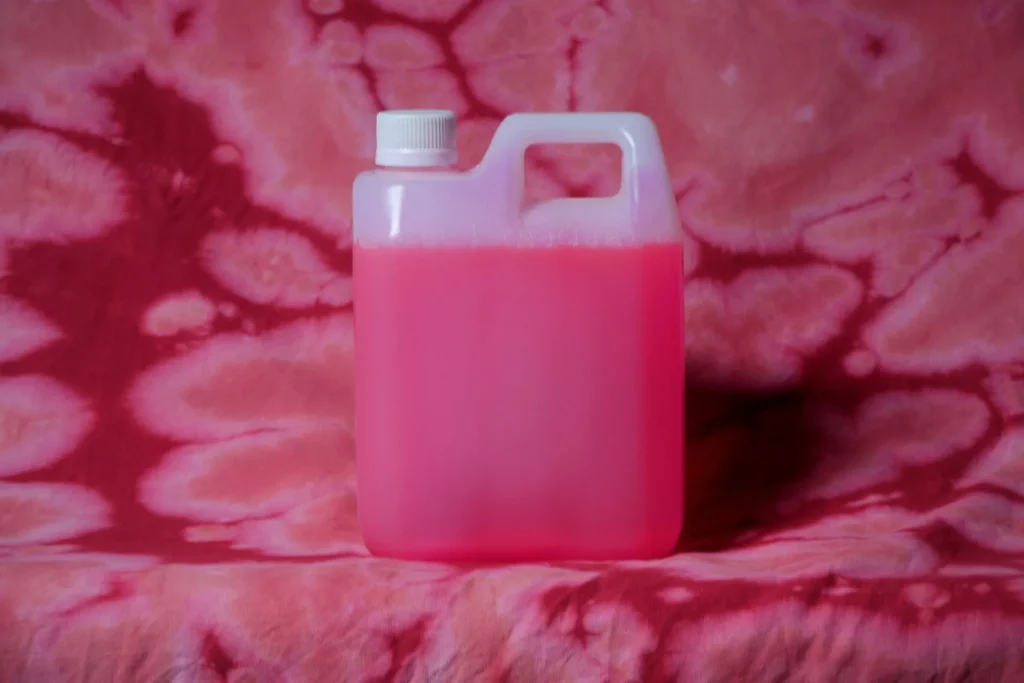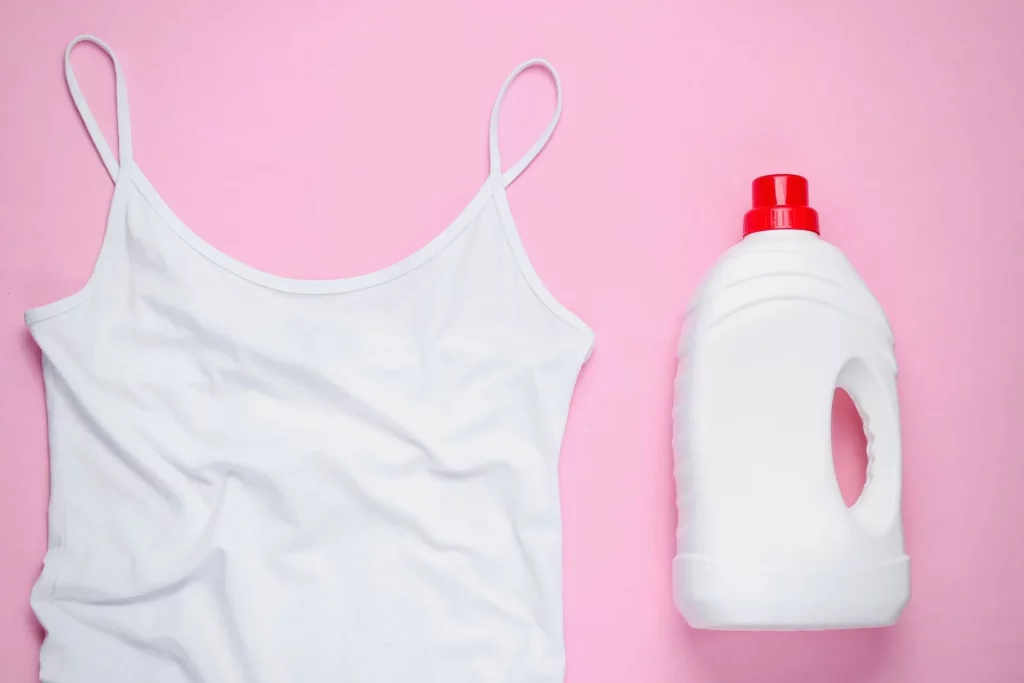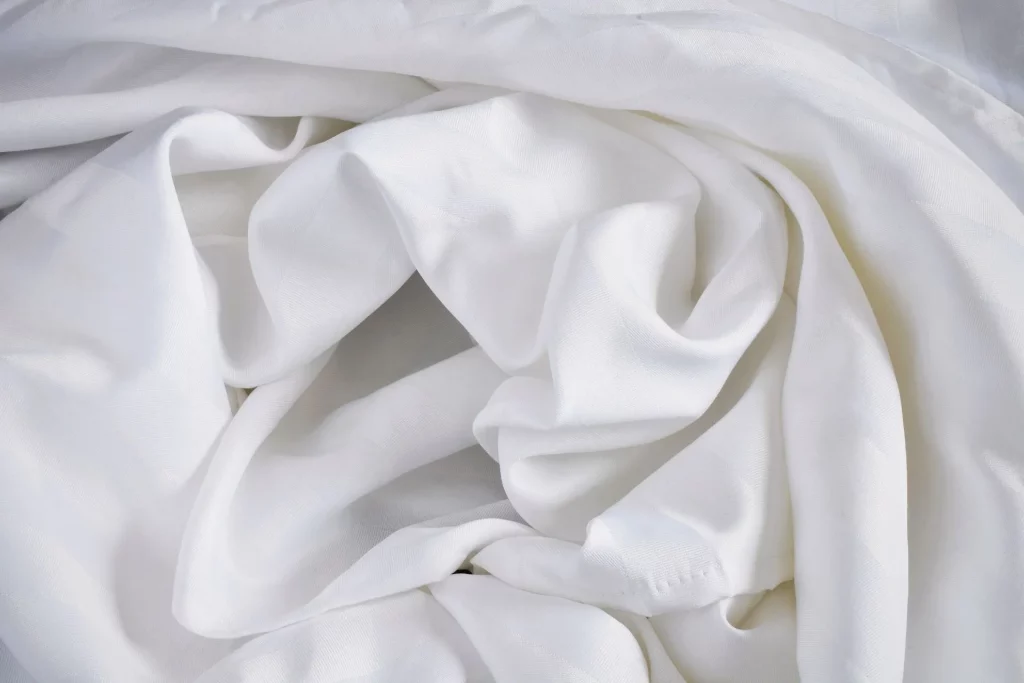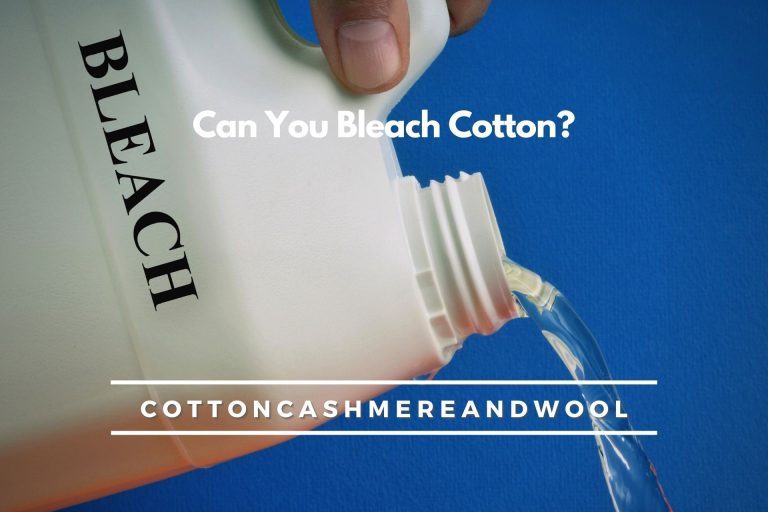Cotton is a favorite fabric used for various garments, household goods, and accessories because of its adaptability and widespread popularity. Because it is long-lasting, comfy, and requires little effort to maintain, it is a popular option among many people.
What happens if you wish to brighten the color of your favorite cotton cloth or unintentionally spill anything on your favorite cotton shirt? If bleaching cotton is possible, what method should be used?
In this article, we will discuss the issue of bleaching cotton, including the many kinds of bleach, the safety measures that need to be taken, and the processes that need to be taken to get the desired outcome. Continue reading if you want to learn more about how to bleach cotton, whether you’re an experienced do-it-yourselfer or just starting in the world of home improvement.
Table of Contents
How to Bleach Cotton?
In order to get rid of stains, lighten the colour of your cloth, or produce a tie-dye look, bleaching cotton might be a quick and efficient solution. Following are the steps for safely and efficiently bleaching cotton:
Pick the appropriate bleach: Chlorine and oxygen bleach are the two forms of bleach that may be used on cotton fibres. Although chlorine bleach is more potent and effective in removing stains, it may severely harm fabric. While oxygen bleach is kinder and safer for colored materials, it might not be as good at removing stubborn stains.
Prepare your workspace: Because bleaching may be messy, shielding your workspace is important. Put old newspapers or plastic down as a work surface cover, then put on gloves to protect your hands.
Create the bleach solution: In a plastic or glass container, combine one part chlorine bleach with three parts water. Be sure to follow the directions on the bottle when using oxygen bleach.
Test a small area: Before bleaching the entire clothing, test a tiny, inconspicuous area to ensure that the bleach won’t harm the fabric or cause discoloration.
Apply the bleach solution: Apply the bleach solution to the fabric by dipping a clean sponge or cloth into the bleach solution. Avoid soaking the cloth by working in tiny portions.
Let the bleach sit: Let the bleach sit for five to thirty minutes, depending on the intensity of the bleach and the desired outcome.
Rinse the fabric: To remove leftover bleach, thoroughly rinse the cloth with cold water. The cloth may also be washed using a light detergent and the cold cycle in the washing machine.
Dry the fabric: Dry the cloth by air-drying it or using a dryer set to low heat.
When bleaching cotton, it’s crucial to take safety precautions because bleach may be dangerous. Always use bleach alone; never combine it with any other cleaning agents. Put on gloves. You may safely and successfully bleach cotton using these procedures to get the desired outcome.
What Happens When You Bleach Cotton?

When used on cotton, bleach should be used to thoroughly clean and remove any stains from the fabric, such as those seen on clothes, bedding, and other items. It is always beneficial to have a perfect goal in mind to strive for. Bleach may be quite effective as a cleaning agent if used properly.
The most important thing is to identify the specific kind of stain that has to be removed. Bleach is ineffective on some of them, including protein stains, and makes the stain even more noticeable. Therefore, you can not expect the desired results without treating protein stains with chlorine bleach.
Sometimes the bleach may cause the cloth to turn yellow or will cause the fibers to become weaker. You risk these things happening when you want your white linens to be as white as possible. Bleaches of the Oxyclean kind or oxygen bleach perform significantly better, even though they are weaker than chlorine bleach.
When you replace the chlorine bleach with oxygen bleach, you might not get flawless results, as these versions operate more slowly than the original, and the oxygen bleach might not be as effective. The same logic has to be used for those natural alternatives to bleach that you can utilize. Try different things out to discover what works best for you, and remember to use old clothes, bedding, or towels as you do so.
Cotton fabrics have varying properties; some resist bleach, others don’t. For Egyptian cotton sheets, follow proper washing instructions to maintain authenticity, and avoid bleach.
How to Bleach 100 Cotton?
There are a few different strategies for bleaching cotton that is one hundred percent. The following instructions will assist you in bleaching your 100% cotton:
- To begin, wash the cotton cloth in hot water with detergent to remove any grime or stains.
- Create a bleaching solution by combining one-fourth cup of bleach with one gallon of water in a container (a sink or bucket works well) and stirring the mixture.
- Soak the cotton material in the bleach solution for five to ten minutes, making sure to agitate it occasionally.
- After soaking the cloth in bleach, thoroughly rinsing it in cold water will eliminate any traces of the chemical that may have been left behind.
- If required, repeat the procedure until the desired degree of brightness has been attained.
- After the piece of cloth has been properly cleaned, it should be washed once more in hot water with detergent to eliminate any remaining bleach.
- The last step is to dry the fabric by exposing it to the sun or using a dryer.
It is essential to remember that bleach may be damaging to materials and that excessive bleaching can cause the cotton fibers to become more fragile. As a result, it is essential to pay close attention to the directions and refrain from bleaching the cloth excessively. When working with bleach, gloves must be worn at all times, and the space in which you work should have adequate ventilation.
How to Bleach White Cotton?

Cotton may be bleached in a manner that is both secure and effective by first having it soaked in a combination of water and bleach solution. About a quarter cup of bleach should be added to a bucket or sink containing one gallon of water. After you have completed this step, you will be able to soak your cotton material in the solution for around 10 minutes before removing it.
If you are satisfied with the level of whiteness, remove the material and give it a last rinse in cold water. Put the item that has been bleached into a combination of hydrogen peroxide and water. This will neutralize any bleach that is still present in the material. Soak the cotton for another five minutes, then wash it as you normally would.
It is possible to accomplish the same thing with a washing machine if it has a dispenser for soap and detergent, both of which must be poured in, and then the machine must be allowed to fill with hot water.
To protect yourself from the potentially harmful effects of an accumulation of chlorine fumes, you should carry out this procedure at a location with enough ventilation. After that, you should put the items of clothes that need to be bleached into the machine and start the cycle. When dealing with stronger stains, the treatment may need to be repeated.
How to Bleach Colored Clothes?
The process of bleaching colored cotton items can be challenging due to the bleach’s potential to discolor or otherwise harm the fabric. The following are some steps that can assist you in bleaching colored cotton clothing:
- Examine the care label attached to the garment to determine whether or not it may be bleached. Do not attempt to bleach the item if the care label does not advocate doing so.
- Examine the material’s response to the bleach in a spot on the garment that won’t be seen by anybody else. After applying a little bleach to the area and waiting for five to ten minutes, rinse the bleach off completely. You are free to bleach the entire garment if there are no discolorations or other signs of damage.
- In a bowl or the sink, combine one part bleach with four parts water to make a solution.
- Put the clothing in the bleach solution, let it soak for ten to fifteen minutes while agitating it occasionally, and then remove it.
- Regularly inspect the clothing to make sure that the color is not deteriorating to an unacceptable degree. Take the garment out of the solution and give it a last rinsing in cold water if the color is fading too soon.
- As soon as you get the whiteness you desire, remove the clothing from the bleach solution and thoroughly rinse it in cold water.
- To eliminate any traces of bleach from the clothing, wash it in hot water with detergent.
- The last step is to dry the item by hanging it outside or using a dryer.
Bleach may potentially ruin colored cotton clothing. Thus, it is vital to remember that you should only use it in very small amounts and only as a last option when cleaning colored cotton. When working with bleach, one should never combine it with other cleaning chemicals and always protect one’s hands by wearing gloves and working in an area with adequate ventilation.
How To Bleach Cotton Yarn?
It’s possible that using hydrogen peroxide will be one of the steps required in completing this task. Although it takes more time and is less powerful than chlorine bleach, this approach is far less hazardous. For this procedure to be successful, the first step is to combine the hydrogen peroxide and water in an equal volume.
You may also try soaking the cotton yarn in a bucket with one-fourth of bleach and one gallon of water. This is still another option available to you. If you only want to remove a basic stain, you only need to let it soak for a maximum of five minutes, but if you want to whiten the yarn, you need to let it soak for an extra five minutes.
There is also the option of using a color remover. This technique is gentler than using bleach, and there is a lower chance that your yarn will become damaged. Caution is advised since some bleaches have the potential to dissolve yarn if it is let to soak for an excessive amount of time.
A good approach to determine whether or not the bleach you are using is safe for the cotton material you are working with is to test the edges of the garments you are washing.
How To Bleach Cotton Sheet?

The first thing you need to do is check whether the bleach will turn those brand-new sheets yellow. It is possible, and you should conduct a test beforehand to ensure that your sheets will not turn yellow when they come into contact with bleach.
You have access to three different cleaning agents, one of which is normal chlorine bleach; however, before putting your sheets into the water, you must ensure that the bleach has been appropriately diluted. If the discoloration is caused by protein, you can start by washing the sheets without bleach, and then on the second cycle, you can add bleach to the wash.
Another detergent you might use is a borax detergent booster, made entirely of natural ingredients and less hazardous to work with than chlorine bleach. Just submerge the sheets in this detergent aid all night, and then proceed with your normal laundering routine the following morning. Oxiclean is a useful alternative to borax in many situations.
Finally, you can use a bluing chemical, but you should use caution. If you don’t follow the directions to the letter, you’ll wind up with sheets that are the wrong color. Applying a very small amount of blueing should remove the yellow stain and restore the white color to your sheets.
How to Bleach Cotton Shirts?
One might use a few different approaches to bleaching cotton shirts. The following instructions will assist you in bleaching your cotton shirts:
- To determine whether or not the clothing can be bleached, look at the label attached. Do not attempt to bleach the garment if the label specifies that it should not be.
- In a bucket or sink, combine a solution consisting of a quarter cup of bleach with one gallon of water.
- Soak the garment in the bleach solution for five to ten minutes, being sure to agitate it occasionally.
- After letting the garment soak for some time, you should give it a thorough rinsing in cold water to eliminate any excess bleach.
- If required, repeat the procedure until the desired degree of brightness has been attained.
- After the garment has been carefully cleaned, it should be washed once more in hot water with detergent to eliminate any remaining bleach.
- The last step is to dry the clothing by hanging it outside or using a dryer.
It is essential to remember that bleach may be damaging to materials and that excessive bleaching can cause the cotton fibers to become more fragile. As a result, it is imperative that you pay close attention to the directions and refrain from bleaching your garment for an excessive amount of time. When working with bleach, gloves must be worn at all times, and the space in which you work should have adequate ventilation.
Does the Use of Bleach Make Cotton Weaker?
You should avoid using chlorine bleach if you have a cotton shirt that is thin or lightweight since it might ruin the clothing. Your cotton shirt may become less durable due to your usage of this powerful chemical, which may also shorten its useful life. If you have light-colored clothing, you might want to avoid chlorine bleach.
Choose an oxygen-based bleach rather than chlorine-based bleach since oxygen-based bleaches are gentler and would be better for your cotton shirts. The chlorine-based bleaches are more powerful than this oxygen bleach, which is only somewhat effective.
If you want to bleach your cotton shirt without causing any harm to the shirt’s fabric, you could try using food based on natural ingredients as a substitute bleaching solution. If you pay close attention to the instructions, you can keep your textiles from becoming weaker or damaged.
Using the appropriate cleaning solution is important to remove stains from the cotton shirt. Bleaching can look simple, but it’s not completely risk-free. The most effective course of action is to look for a chlorine-free alternative compatible with your materials. Because there are so many differences between textiles, you must select the one that is most appropriate for the material you have on hand.
Why Is My Cotton Shirt Not Bleaching?
It’s conceivable that the bleach won’t function as planned while attempting to bleach a cotton garment. There are several potential causes for this. The fact that the cloth may not be entirely cotton is one scenario that might make it more challenging for the bleach to bleach the fabric.
The cloth can also be dirty or discolored, hindering the bleach from doing its job. The bleach solution could also not work as effectively if it is too weak or has expired. Because bleach works best in hot water, the water’s temperature can also affect how well something is breached.
The garment may not bleach evenly if not completely immersed in the solution. When attempting to bleach a cotton shirt, it’s crucial to keep these things in mind and to follow the directions to prevent fabric damage carefully.
Frequently Asked Questions:
Does Cotton Decay in the Presence of Bleach?
The chlorine in bleach weakens cotton fibers, so garments made from them may eventually wear out at the seams if they are delicate. When I need my whites to be truly white, I turn to Oxyclean.
Will Cotton Fade If It Gets Bleached?
If you must bleach your garments, select only those crafted from cotton. Bleach will greatly brighten polyester and rayon blends but negatively react with them. I wore an all-cotton tee underneath a sweatsuit made of 60% cotton and 40% polyester. It’s time to start using the bleach.
Bottom Line:
When it comes to cotton, bleaching is OK. Please use caution when doing so. Too much bleach may harm fabrics and cause them to fade or become yellow. It would be best if you also were wary of the washing instructions. To know when they are speaking the truth and when they are not might be a game of Russian roulette at best. Wear protective gear and use caution whenever bleach is used. Find a substitute for chlorine bleach if you can. It’s safer to do so.

